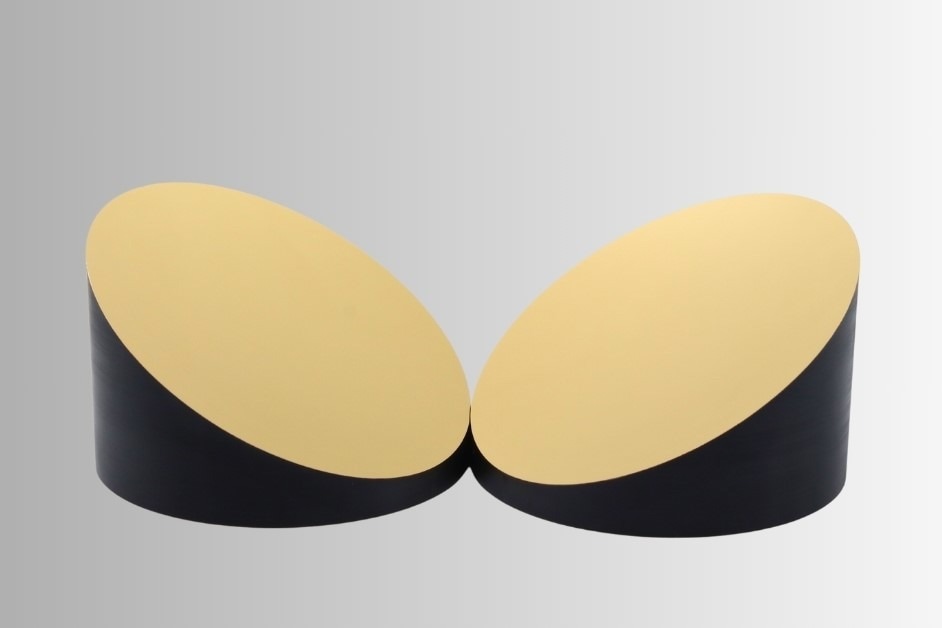In this interview, the Avantier Engineering team discusses the design, geometry, and practical applications of off-axis parabolic mirrors in a range of scientific and optical system settings. Watch the full video or read the selected highlights below.
What is an off-axis parabolic (OAP) mirror, and how is it different from a standard parabolic mirror?
An OAP mirror is essentially a segment taken from a larger parent parabolic mirror, but it's offset from the central optical axis.
Instead of reflecting light back along the same axis like a typical on-axis parabolic mirror, an OAP redirects the reflected beam away from the incoming path. This geometry preserves the paraboloid’s excellent focusing properties - specifically, its ability to bring collimated light to a single point without introducing spherical aberration - while also allowing unobstructed access to the focal point.

Image Credit: Avantier Inc.
What are the main advantages of using an off-axis configuration?
The off-axis configuration eliminates beam path overlap - a common challenge in on-axis systems. This allows for optical setups where the input and output beams remain separate, avoiding interference and making system integration much cleaner. OAPs also maintain diffraction-limited performance and offer physically accessible focal points. Their geometry is particularly valuable in space-constrained systems or setups that would otherwise require complex beam folding.
Can you explain the basic geometry and design parameters of an OAP mirror?
The geometry of an OAP is defined by three key parameters:
- Parent focal length: This refers to the focal length of the full paraboloid from which the OAP is sectioned. It’s the distance from the paraboloid’s vertex to its focus and is determined by the curvature of the parent mirror.
- Off-axis distance: This is the lateral displacement from the optical axis of the parent mirror to the center of the OAP segment. It influences both the mirror’s size and the position of its focal point.
- Off-axis angle: This is the angle between the incoming collimated beam and the reflected focused beam. Increasing the off-axis distance also increases this angle, which can be useful when designing compact optical paths.
Together, these parameters enable compact, efficient optical designs without compromising performance.
Why is the off-axis geometry functionally superior in certain optical systems?
It really comes down to accessibility and optical performance. As OAPs eliminate the overlap between input and output beams, they’re ideal in applications where open space near the focal point is essential, like in laser delivery systems that require mechanical access to the focus. They’re also perfect for situations where using transmissive optics would introduce chromatic aberrations or energy losses.
Because they’re reflective elements, OAPs are inherently achromatic and effective across a broad spectral range, from ultraviolet (UV) to far-infrared (FIR).
What makes OAPs beneficial for compact and portable system designs?
Their ability to fold the optical path into a small footprint is a major advantage. In space-constrained applications like aerospace systems or field-based instrumentation, every millimeter counts. OAPs make it possible to create designs that are both highly space-efficient and optically robust. Because they are monolithic components, they also simplify alignment and reduce the number of optical surfaces, which helps minimize scattering and improves the overall signal-to-noise ratio.
How are OAP mirrors used in spectroscopy?
In spectroscopy, OAPs are commonly used to focus light into narrow entrance slits or directly onto detectors. This makes them well-suited for high-throughput designs, especially when space and alignment accuracy are critical. Their precision focusing capabilities help improve resolution and efficiency, which is vital in analytical instruments.
What role do OAPs play in interferometers and metrology?
OAPs are extremely valuable in interferometry because they provide clean, aberration-free focusing, which is essential for maintaining wavefront integrity and accurate phase measurements. In optical testing and metrology, they also help generate precise wavefronts for beam shaping and calibration. Their ability to produce distortion-free reflections is key to the reliability of these systems.
Why are OAPs preferred in high-power laser systems?
In high-power laser systems, OAPs outperform glass lenses when it comes to collimating beams. They help minimize energy loss by avoiding the absorption and dispersion that can occur in transmissive optics. Their reflective nature also prevents thermal issues that arise in high-energy environments, making them a more robust and durable option.
What are some other industries or systems where OAPs are commonly used?
Beyond spectroscopy and metrology, OAPs are widely used in astronomy, where they help fold long optical paths into compact configurations, particularly useful in adaptive optics systems.
They're also popular in experimental physics setups, commercial optical instruments, and aerospace platforms. Their versatility and reliability make them a go-to solution across many high-precision optical applications.
Watch the full video
Webinar: Exploring Off-Axis Parabolic (OAP) Mirrors for Advanced Optical Systems
Video Credit: Avantier Inc.

This information has been sourced, reviewed, and adapted from materials provided by Avantier Inc.
For more information on this source, please visit Avantier Inc.
Disclaimer: The views expressed here are those of the interviewee and do not necessarily represent the views of AZoM.com Limited (T/A) AZoNetwork, the owner and operator of this website. This disclaimer forms part of the Terms and Conditions of use of this website.